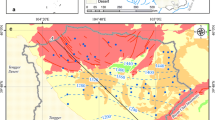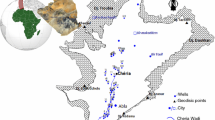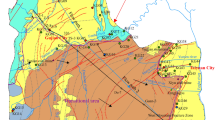Abstract
Complex structural systems, lithological differences, and extreme heterogeneity of aquifers combine to create a complex karst aquifer structure in alpine and gorge areas; however, because of the topography, direct investigation of aquifer structure is difficult. In this study, field survey, hydrochemical, and isotopic data are analyzed to reveal the development of karst groundwater and to describe the karst water cycle in Genie Mountain, Qinghai–Xizang Plateau. The results show that groundwater circulation is mainly controlled by active fracture. Atmospheric precipitation and melting ice and snow are the groundwater recharge sources, and recharge areas are mostly located in high mountains above 4500 m a.s.l. The direction of groundwater flow is mostly controlled by the Jinshajiang active Fault, with drainage areas at the intersection of multiple faults. There are two regional karst water runoff conduits. One is along the Edexi-Hongjunshan Fault, where groundwater runs from south to north; the other is along Gangtonglong Fault, where groundwater runs from north to south, and is discharged at Gangtonglong gully. The groundwater cycle can be divided into three levels: epikarst water circulation; mid to deep karst water circulation; and deep geothermal water circulation. The karst springs located in the outlet of the Huolong gully contain markedly higher levels of Na+ and SO42− than other karst springs because of the leaching effect of groundwater on mirabilite. The presence of evaporites in Huolong gully indicates that the plateau planation formed by the structural uplift will change the local climatic conditions, and then affect the groundwater circulation process and the water–rock reaction in the process.














Similar content being viewed by others
Data Availability
The data used to support the findings of this study are available from the corresponding author upon request.
References
Aldalla OAE (2009) Groundwater recharge/discharge in semiarid regions interpreted from isotope and chloride concentrations in north White Nile Rift. Sudan Hydrogeol J 17(3):679–692
Bicalho CC et al (2017) A conceptual model for groundwater circulation using isotopes and geochemical tracers coupled with hydrodynamics: a case study of the Lez karst system, France. Chem Geol. https://doi.org/10.1016/j.chemgeo.2017.08.014
Cao R (2020) Hydrochemical characteristics and genesis analyses of the hot springs in the Batang area of Sichuan Province. A Dissertation Submitted to China University of Geosciences for Master of Professional Degree
Cao R, Zhou X, Chen B, Li Z (2020) Analysis of water chemical characteristics and causes of hot springs and geysers in Chaluo area, Batang of Sichuan. Earth Sci Front https://doi.org/10.13745/j.esf.sf.2020.6.35 (in Chinese)
Darnault CJG (2008) Karst aquifers: hydrogeology and exploitation. Overexploitation and contamination of shared groundwater resources
Fan H, Zhang Y et al (2018) Hazards and treatment of karst tunneling in Qinling-Daba mountainous area: overview and lessons learnt from Yichang-Wanzhou railway system. Environ Earth Sci 77(19):679
Ford D, Williams P (2007) Karst hydrogeology and geomorphology. Wiley, Chichester
Gat JR (1996) Oxygen and hydrogen isotopes in the hydrologic cycle. Annual Rev Earth Planet Sci 24(1):225–262
Goldscheider N, Drew D (2007) Methods in karst hydrogeology. Taylor and Francis, London
Li Y (2019) Influence of characteristic factor migration on groundwater environment in typical geothermal water areas in Western Sichuan. Thesis (in Chinese)
Li SC, Liu RT, Zhang QS, Zhang X (2016) Protection against water or mud inrush in tunnels by grouting: a review. J Rock Mech Geotech Eng 8(5):753–766
Li W, Wang J, Wang J (2018) Characteristics of the stable isotopes in precipitation and the source of water vapor in different terrain in the southwest region. Resour Environ Yangtze Basin 27(5):1132–1142 (in Chinese)
Li CS, Ding JF, Liao YK, Lu S (2020) Analysis on environmental impact factors of tunnel karst dynamics system in typical areas. Groundwater Chemical kinetics and fractal characteristics of Karst Tunnel. Singapore, Springer Singapore, pp 15–49
Li SC, Liu B, Nie LC, Liu ZY, Tian MZ, Wang SR, Su MX, Guo Q (2015) Detecting and monitoring of water inrush in tunnels and coal mines using direct current resistivity method: a review. J Rock Mech Geotech Eng 7(4):469–478
Lin CJ, Zhang M, Zhou ZQ, Li LP, Shi SS, Chen YX, Dai WJ (2020) A new quantitative method for risk assessment of water inrush in karst tunnels based on variable weight function and improved cloud model. Tun Undergr Sp Tech 95:103136
Liu Y, Feng YN, Xu M, Zhang YH, Long HT, Zhu HM (2019) Effect of an incremental change in external water pressure on tunnel lining: a case study from the Tongxi karst tunnel. Nat Hazards 98(2):343–377
Maloszewski P, Willibald S, Andrzej Z, Dieter R (2002) Identifying the flow systems in a karstic-fissured-porous aquifer, the schneealpe, Austria, by modelling of environmental 18O and 3H isotopes. J Hydrol 256(1–2):59
Mcguire K, Mcdonnell J (2008) Stable isotope tracers in watershed hydrology. Stable isotopes in ecology and environmental science, 2nd edn. Blackwell Publishing Ltd.
Perrin J, Jeannin P-Y, Zwahlen F (2003) Epikarst storage in a karst aquifer: a conceptual model based on isotopic data, Milandre test site, Switzerland. J Hydrol 279(1):106–124
Rusjan S, Sapač K, Petrič M, Sonja L, Nejc B (2019) (2019) Identifying the hydrological behavior of a complex karst system using stable isotopes. J Hydrol 577:123956
Song C, Sun X, Wang G (2015) A study on precipitiation stable isotopes characteristics and vapor sources of the subalpine Gongga Mountain, China. Resour Environ Yangtze Basin. 24(11):1860–1869 (in Chinese)
Tomasz K, Linda C, Joanna N (2019) Application of dissolved gases concentration measurements, hydrochemical and isotopic data to determine the circulation conditions and age of groundwater in the Central Sudetes Mts. J Hydrol 569(2019):735–752
White WB (2002) Karst hydrology: recent developments and open questions. Eng Geol 65(2–3):85–105
Wu X, Cai C (1992) The neotectonic activity along the central segment of Jinshajiang Fault zone and the epicentral determination of Batang M 6.5 earthquake. J Seismol Res 15(4):401–410 (in Chinese)
Wu Y, Fang H, Huang L et al (2020) Changing runoff due to temperature and precipitation variations in the dammed Jinsha River. J Hydrol 582:124500
Xia R (2016) Groundwater resources in karst area in Southern China and sustainable utilization pattern. J Groundwater Sci Eng 4(4):301–309
Yao ZJ, Liu J, Huang HQ, Song XF, Dong XH, Liu X (2009) Characteristics of isotope in precipitation, river water and lake water in the Manasarovar basin of Qinghai-tibet plateau. Environ Geol 57(3):551–556
Yin LH, Hou GC, Su XS, Wang D, Hao YH, Wang XY (2011) Isotopes (δD and δ18O) in precipitation, groundwater and surface water in the ordos plateau, China: implications with respect to groundwater recharge and circulation. Hydrogeol J 19(2):429–443
Zabidi H, De Freitas MH (2013) Geospatial analysis in identifying karst cavity distribution: The SMART Tunnel, Malaysia. Carbonates Evaporites 28(1):125–133
Zhang WJ, Chen X, Tang HB, Zhang YF, Cao JF (2015) Geochemical and isotopic data for restricting seawater intrusion and groundwater circulation in a series of typical volcanic islands in the South China sea. Mar Pollut Bull 93(1–2):153–162
Zhao J, Zhang W, Zhang H, Qu Z, Li M, Yue G (2019) Hydrogeochemical characteristics and genesis of the geothermal fields in Batang of Sichuan. Hydrogeol Eng Geology. 46(4):81–89 (in Chinese)
Zheng T, Jiao T, Hu B, Gong J, Hou X, Wang H (2021) Groundwater chemical characteristics and genetic analysis in the central area of the Wohe River Basin. Environ Sci https://doi.org/10.13227/j.hjkx.202006037.
Acknowledgements
We are very grateful to the reviewers for their insightful, important, and constructive comments that improved the final version of the manuscript. We also thank this organization for funding our research. We also thank Lucy Muir, PhD, from Liwen Bianji, Edanz Editing China (www.liwenbianji.cn/ac), for editing the English text of a draft of this manuscript.
Funding
This research was financed and conducted under the terms of the Geological Survey Project of China Geological Survey Bureau (project numbers DD20201123, DD20211374 and DD20221812); we thank this organization for funding our research.
Author information
Authors and Affiliations
Corresponding author
Ethics declarations
Conflicts of interest
The authors declare no conflict of interest.
Additional information
Publisher's Note
Springer Nature remains neutral with regard to jurisdictional claims in published maps and institutional affiliations.
Rights and permissions
About this article
Cite this article
Ma, J., Li, X., Liu, F. et al. Application of hydrochemical and isotopic data to determine the origin and circulation conditions of karst groundwater in an alpine and gorge region in the Qinghai–Xizang Plateau: a case study of Genie Mountain. Environ Earth Sci 81, 291 (2022). https://doi.org/10.1007/s12665-022-10414-9
Received:
Accepted:
Published:
DOI: https://doi.org/10.1007/s12665-022-10414-9




